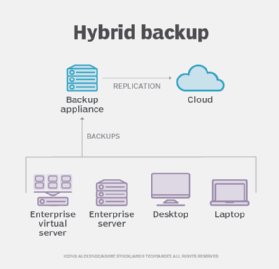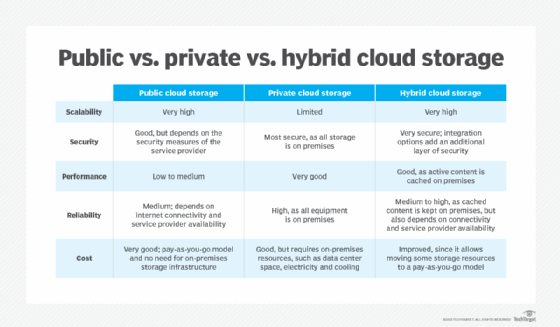hybrid backup
What is a hybrid backup?
A hybrid backup is typically when organizations use both on-premises storage and the public cloud as data backup destinations, depending on specific requirements and use cases. A hybrid backup can also involve backing up to a public cloud and a private cloud, but this approach is less common.
When planning or updating a data storage strategy and architecture, several conditions must be considered, including the following:
- which data is more frequently used for business needs;
- which data is less likely to be used;
- which data will be needed in a disruptive event; and
- how quickly important data can be retrieved from a storage location.
Considering the many different approaches to data backup and storage, a hybrid configuration is worth considering. Hybrid backup is a blend of different backup and storage methodologies. The result is a backup configuration that can deliver critical data quickly in an emergency and can also provide a secure repository for all kinds of data, databases, VMs and applications.
One widely used hybrid configuration combines on-premises storage in the form of a network-attached storage (NAS) appliance with a cloud-based storage arrangement. The NAS device holds data that is more likely to be needed for the business and in the event of an emergency. Data stored in the NAS device can also be backed up to a cloud repository for short-, medium- and even long-term storage.
Data backed up to the NAS device can be automatically backed up to a cloud service as a secondary backup. Such an arrangement provides near-real-time data retrieval from the NAS, while the cloud provides an alternate arrangement. Remember that the speed of retrieval and restoration can differ significantly between the two storage methods.
This article is part of
What is cloud backup and how does it work?
How do hybrid backups work?
In its most basic form, a hybrid backup starts with the primary user application that requires something to be backed up. Depending on the criticality of the data and likelihood it will be needed again soon, the application handling storage and backups can send the data via a local area network (LAN) or storage area network (SAN) to a local NAS device for rapid retrieval when needed.
The user's storage application can also send a copy of the data being backed up to a cloud service, usually via the internet or a wide area network connection. Such a cloud is usually considered a public cloud, such as AWS, Microsoft Azure and Google Cloud.

Alternatively, data can be backed up to a private cloud, which is used solely by the user and can be deployed in a public cloud service, a managed service provider or a user-deployed cloud arrangement, e.g., at an alternate data center.
Further, the NAS device can serve as the routing point for data being sent to a cloud. As it receives data from the user system, it stores the data locally and also sends it to a cloud service. This arrangement greatly simplifies the process of hybrid backup.
Figure 1 depicts the basic architecture of hybrid backup, as defined previously.
Hybrid backup planning considerations
The hybrid architecture selected must be based on a careful analysis of historic and anticipated data storage and recovery activities. Experience with the requirements of disaster recovery (DR) should also be considered. In addition to potential investments in hardware, software and network connectivity, users must also be aware of costs associated with a cloud backup arrangement, such as storage capacity fees, data retrieval fees, network fees, geographic adjustments and cloud departure fees.
If the user organization is considering a migration from its existing on-premises storage architecture to a more robust, secure and survivable arrangement, a hybrid configuration makes good sense. It can be designed in phases, e.g., update the existing backup and storage software to direct storage of certain data to a new storage platform, such as a NAS appliance. A subsequent phase can introduce cloud storage where the NAS captures data backups and selectively routes them to the cloud service.
An important consideration is the network resources that will be used to transport data from its origination to its backup location. If this is done locally using a SAN or LAN, the speed can be very fast (gigabytes per second). Data from the NAS can be retrieved almost instantly and returned to production systems. If a cloud service is used, the speed of retrieval and recovery can be somewhat longer due to bandwidth restrictions. Metrics such as a recovery time objective (RTO) must be factored into decisions on storage location and method.
Benefits of hybrid backups
The following examples are benefits of using a hybrid backup arrangement:
- Cloud backups can help protect data in case of a ransomware attack; while short-term data stored on a NAS can be locked, the same data that has been backed up to a cloud isn't likely to be affected and can subsequently retrieved.
- DR activities can be implemented using hybrid backups for rapid recovery of local mission-critical files, and if local storage is disabled, the same resources can be retrieved from the cloud.
- Movement of workloads -- located in containers, for example -- can be facilitated between hybrid clouds using public and private, if they are both in use, based on operational requirements, e.g., the most frequently used systems are backed up to a public cloud.
- Situations in which users already have a private hybrid cloud but need more storage space can use public clouds and save money in the process.
- Users can have increased scalability and agility with hybrid arrangements, while also keeping costs under control. Moving some data to the cloud and keeping other key data on premises provides savings because it reduces the amount of on-premises storage equipment, floor space and possibly the number of staff needed in the data center.
Figure 2 provides a side-by-side comparison of public, private and hybrid cloud arrangements based on several important criteria.

Limitations of hybrid backups
Hybrid clouds are often considered an excellent balance of local backups and cloud technology. However, as with any cloud backup, configuration factors such as cost, network bandwidth needed, scalability, ease of migration between clouds, ease of management and security must be factored into the equation and can become limitations. Specific requirements for backups must also be defined, e.g., storage data capacity needed, criticality of data and RTOs.
Additional limitations of a hybrid backup arrangement can include the need to manage multiple vendors and potential difficulty viewing resources in the associated cloud service.
Any of these criteria can have a negative effect on the overall storage architecture, which is why data backup and storage policies should be implemented. A data lifecycle management policy can be even more important, as it specifies the characteristics of all kinds of data, from creation to storage to destruction.
Hybrid vs. cloud backups: Key differences and considerations
Figure 2 delineates how hybrid clouds compare to public and private clouds. Interestingly, hybrid backup configurations can include cloud and non-cloud storage elements, as seen in Figure 1. Cloud backups can be to a single cloud or multiple clouds, depending on user requirements.
Hybrid clouds can also be heterogeneous or homogeneous. The former employs multiple clouds from different vendors, whereas the latter is typically a package from a single vendor that bundles one or more clouds, plus additional technology -- such as NAS appliances or security software -- that facilitates ease of administration, monitoring, security and DR.
Homogeneous clouds are generally easier to manage because the user is dealing with only one vendor. Conversely, this same benefit can be a limitation if it causes vendor lock-in, which can make it difficult and costly to leave that vendor.
Heterogeneous clouds can be more challenging to build, but because no single vendor is used, organizations can have greater control over their decisions regarding cloud vendors, backup architectures and services being used.
Which backup strategy is right for you?
As noted earlier, the backup process should be defined with policies and procedures. Choosing the right backup strategy should be part of these policies and procedures. A data lifecycle management policy and data management policy can also specify one or more backup strategies.
Companion strategies should address retrieving, recovering and reconstituting backed-up data so it can be put into production. Whether the backup strategy must address local backup, access to remote servers, regulatory and standards compliance, data protection measures or support for business continuity, hybrid backup has been shown to be cost-effective, secure, flexible and easy to manage.








